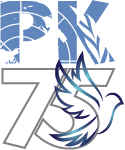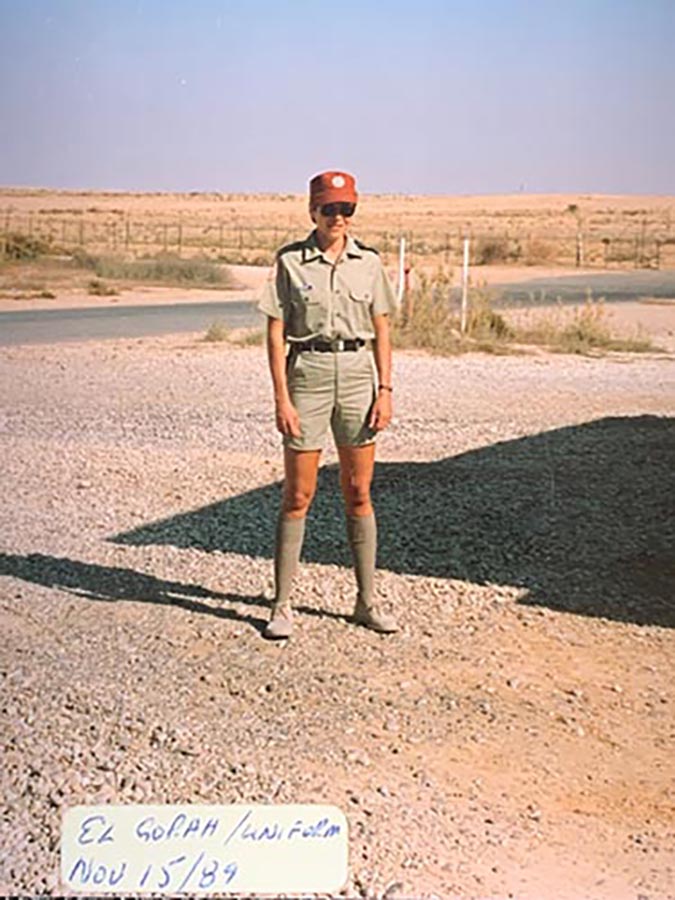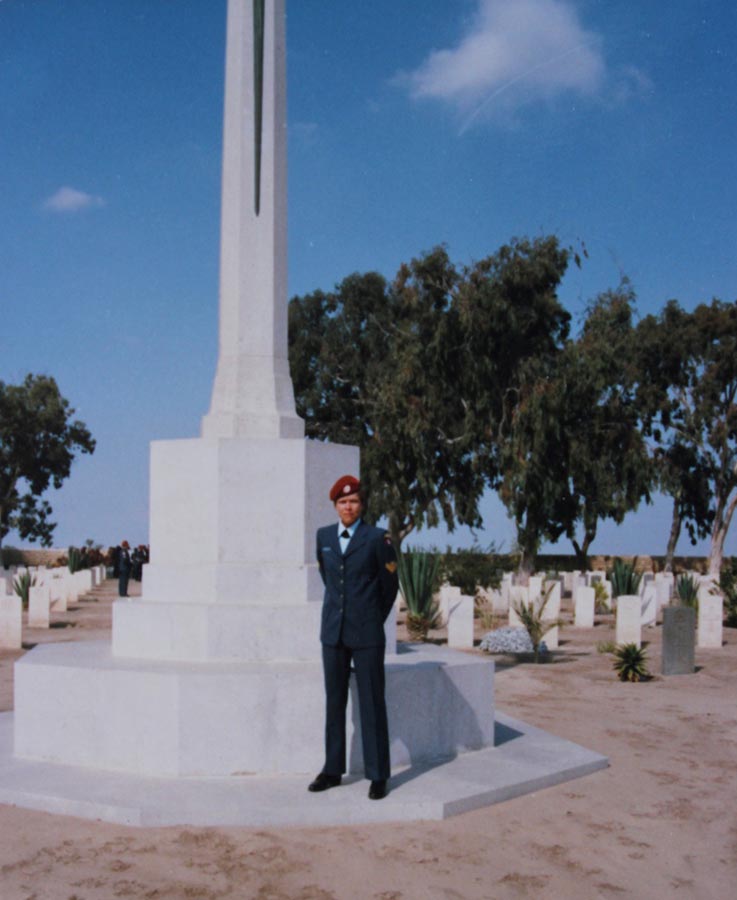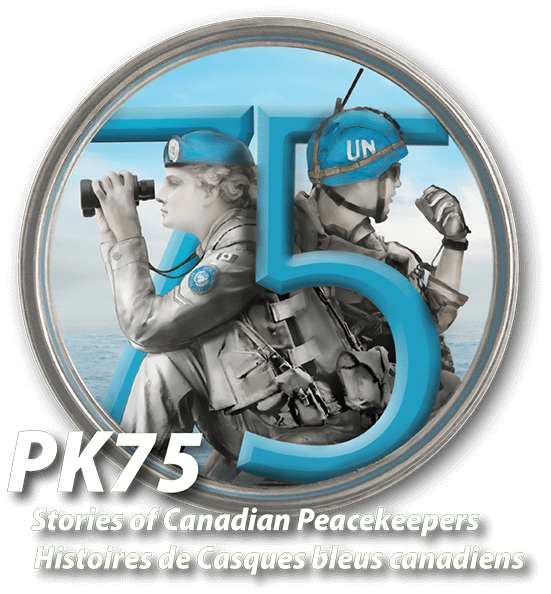

Rainy River, ON, Canada
Lynne Gouliquer
Current Location: Sudbury, ON, Canada
Multinational Force and Observer Peacekeeping Mission
Following my posting to 403 (Helicopter) Squadron of Canadian Forces Base (CFB) Gagetown in July 1989, I barely had time to get to know my fellow aviators - and shortly thereafter, about 150 of us left for the Sinai Peninsula in mid-September. It was a whirlwind for me as everything went into storage, including my car. It was 403 Squadron’s turn to take part in the Multinational Force and Observers (MFO) peacekeeping mission. Established in 1981, this peacekeeping mission was comprised of an international force from 13 countries who oversee that Egypt and Israel are respecting their 1979 treaty agreement. We wore a distinctive terracotta-coloured beret and tan-beige uniform as the MFO was a separate peacekeeping organisation and not under the United Nations’ jurisdiction. Canada supported the mission with its rotary-helicopter units (408, 427 and 430 Tactical Helicopter Squadrons and 403 Operational Training & Helicopter Squadron) from 1985 to 1990 (see mfo.org). We were the last helicopter squadron to contribute to the MFO.
There were two MFO military camps, El Gorah or the North Camp, and Sharm El Sheikh, the South Camp. We were located in the North Camp, minutes from the Mediterranean Sea. I was an air weapons technician by trade and provided the related mechanical support for the white painted CH135 Twin Huey helicopters. Given the French air transport contingent and our helicopters flew quite regularly to the South Camp, it was relatively easy for me to hitch a ride and go down for the weekend. South Camp had a small beach carved in the rocks on the tip of the Gulf of Aqaba and it was there that I first enjoyed snorkelling and experiencing the marine life of the Red Sea/Gulf of Aqaba.
Given that all members of the LGBTQ community were being kicked out of the Canadian military prior to 1991, like many others, as a lesbian, I went as an officially single soldier to protect my career. Consequently, it was a rather lonely and isolating mission as I had to always be on guard and pretend that I was heterosexual. I only knew of one other lesbian on that tour. She was from another base, a different trade, and our paths did not cross often. What I do remember is the fear of being discovered and that my heterosexual colleagues often talked about their wives, husbands and family back home, and I dared not. Thus, I lost out on sharing an important part of my life and receiving support from my colleagues.
The mission at that time was relatively peaceful in nature and luckily, in our downtime, we could travel. Maybe that is why Canada left the MFO at that time as it foresaw the need to contribute shortly thereafter to the Gulf War. Given El Gorah was literally only a few hours away from Jerusalem, I was able to visit it on numerous occasions. The views from walking the tops of its ramparts overlooking the old city remain with me to this day. I also explored Cairo and its Egyptian museum with King Tutankhamen’s gold ornate artifacts and the famous Egyptian pyramids. I ventured into Jordan for four days of car travel alone as a woman. Today, I marvel at either my bravery or naivety. The squadron hiked up Mount Sinai at night to see the sun rise and then on the way down, we picked up garbage as a contribution to keeping the landscape clean.
I also ran in the Tiberias Marathon in January 1990 finishing in 4 hours and 35 minutes. It was my one and only marathon. For this 42-kilometre international race, we ran out along the southern shores of the Sea of Galilee and shortly after crossing the River Jordan we turned around and ran back. I was the only MFO Canadian, though other contingent countries’ members ran such as from Holland and the United States.
While Egypt and Israel were relatively at peace for the duration of our peacekeeping mission, the gender violence I experienced as a woman was traumatic: to this day, I am still challenged by PTSD symptoms and triggers. Peacekeeping missions like this one are full of gender violence but not necessarily from the outside forces as one might expect. It was perpetrated primarily from the guys on the inside; in this case, the MFO members. The violence was directed at me simply because of my gender. Some of my own male colleagues and members of the other peacekeeping nations could not be trusted and did do harm. While I like to highlight the positive aspects, I want to acknowledge and honour all of my memories of the mission.
Biography
I am Métis from the North-West Triangle, Treaty Three Territory (e.g., Lake of the Woods area) of Northwestern Ontario. While three quadrants of my heritage are Métis, Margaret Smith (née Mathieson) is my Métis root ancestor of the Goodwin-Mistigoose lineage. I first joined the Canadian Armed Forces in 1976: I turned 19 while in Boot Camp in Cornwallis, NS. I joined as an Air Weapons Technician, my second choice given the Infantry was closed to women as were many other military trades and postings at the time. Farm life prepared me well for the military; CFB Cornwallis and basic trades training in CFB Borden were challenging, but only because I was learning something entirely outside of any relatable experiences in my life.
It was in both of these places that I began to understand that liking and loving someone of the same gender was not accepted and should be hidden. Women friends and acquaintances simply disappeared from my life. It was only the rumours that informed me that they were discharged due to “homosexuality” in accordance with the official policy at the time, articulated in the infamous Canadian Forces Administrative Order (CFAO) 19-20, which declared homosexuality a sexual abnormality and was grounds for discharging soldiers.
Although I requested CFB Bagotville so that I could learn French, my first posting was to CFB Comox, 407 Maritime Squadron. Vancouver Island and military work were fabulous. I went on short missions with the 407 Squadron to places such as Yellowknife in the Northwest Territories and Honolulu, Oahu (Hawaii). As part of the ground crew, we were required to maintain the aircraft during these exercises. While in Comox, I enjoyed swimming in the military’s outdoor pool year-round. In the late 70s, I completed the next higher level of my trades training at two different bases: CFB Kingston for electronics training and CFB Borden for Air Weapons Technician. In 1980, I applied and was accepted for the UTPM program (University Training Program for Members) to become an officer. I went to Chilliwack for basic officer training and after successfully passing it I subsequently started university at CMR (i.e., Royal Military College in St Jean, QC).
In January 1981, I released from the Canadian Armed Forces (CAF) and returned to farming, but only for three years. In 1984, I rejoined the CAF and again as an Air Weapons Technician and was posted to CFB Cold Lake. Upon receiving my appointment to Master Corporal in 1988, the military cut a message posting me to a ship. Upon learning of my gender; however, they cut a new message and posted me to 403 Squadron, CFB Gagetown. It was not until post 1989 that women could be posted to military ships. During the early 90s, I also met and fell in love with my present spouse (Carmen Poulin). It was the summer of 1991. She thus became part of the clandestine group of women hiding their sexuality and lives due to military law. Though the military officially had to stop discriminating against the LGBTQ community the end of 1992, we did not feel comfortable or safe coming out: this did not start to happen till about 2000.
I left the military for good at the end of 1995. Originally, I referred to my departure as a friendly divorce in which both parties separated on amicable terms; however, I have come to realise that I was like a pit in a lemon. I was squeezed out because I was no longer a good fit as a woman and a lesbian.
Upon leaving the military, I completed my graduate education (MA & PhD) in Sociology at McGill University. My BA, MA, and PhD research focussed on different aspects of the Canadian military. During my time as a PhD student, my life partner (Dr Carmen Poulin) and I received national funding from the Social Sciences and Humanities Research Council (SSHRC) to study the effects on LGBTQ military members of the rescinded CAF policy (CFAO 19-20) on homosexuality (p-sec.org/en/project/the-purge-lgbt-soldiers-partners). We interviewed 160 CAF members and some of their partners and wrote numerous articles about their struggles and lives (p-sec.org). This research also allowed us to provide advice concerning the wording of Prime Minister Trudeau’s 2017 historic apology to the LGBTQ community and military Purge veterans of Canada (www.youtube.com).
Drawing on our landmark research, we also wrote an evidence-based report detailing what happened to military members during the Purge era. Our research was effectively leveraged in the successful 2018 “Purge Class Action Settlement” with the Government of Canada, worth up to $145 million toward individual compensation for survivors and special projects toward reconciliation and memorialization. As part of another nationally funded study, we are currently redoing a very similar study: we are recruiting and interviewing 2SLGBTQIA+ currently serving military members and their partners to tells their stories about their military lives and experiences (p-sec.org/en/project/lgbtqia2s-in-canadian-military-25-years-anti-homosexuality).
Amazingly this study is funded by the Sciences and Humanities Research Council and Defence Research and Development Canada (Department of National Defence Research Initiative; DNDRI). After successfully garnering a two-year Banting Postdoctoral Fellowship in 2012, which I held at St. Thomas University in Fredericton, New Brunswick, I applied and was offered a position in 2015 to teach sociology at Laurentian University where I have been ever since.




